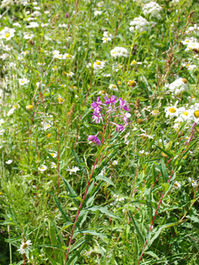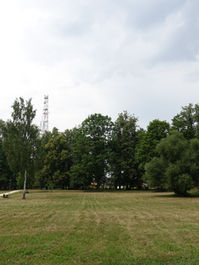Review studies of biological diversity in Bebrinė, Lūznava and Preili manor parks (Latvia)
2021-08-03

2021 July PI wetland restoration and protection fund experts conducted sightseeing biodiversity research in historical Beaver (lv. k. Bebrenes) Lūznava (Lūznavas) and Preiļi (Preili) estates parks in Latvia. Particular attention was paid to the inventory of mature trees (tree ancestors) and their condition. The aim of the research is to provide suggestions related to the conservation of biological diversity to the owners and responsible organizations managing and restoring historic parks.
All of these parks are designed in the English landscape park style and are among the most visually expressive landscape parks in southeastern Latvia. Landscape parks delight visitors not only with their greenery, but also with the abundance of water bodies. The harmonious architectural accents of the manors and the trees that date back to the first century and are of exceptional forms (for example, multi-stemmed lime) give the parks a special eco-aesthetic value. Well, and properly cared for, old oaks, lindens, ashes and even willows are valuable not only aesthetically, but also in terms of biodiversity - each such tree becomes a separate ecosystem in which life actively boils - both inside and outside the tree… Usually the tree the older it is, the more likely it is to be rich in biodiversity. Sometimes a wooded tree with withered branches gives people doubt and a sense of insecurity, but it is a vital refuge for a rare or less rare species of fungi, lichens, insects, birds, and even mammals. It is gratifying that in the parks of Latvian manors, valuable trees are marked with special signs - ancient and natural monuments, and the most impressive of them are presented to visitors on specially equipped stands. In addition, naturally cooked or cut tree trunks are left in all the parks studied for biodiversity purposes!
During the expeditions, attention was also paid to the condition of meadows and lawns in historical parks. It is gratifying that the organizations managing the parks understand the importance of natural meadows or their fragments for the maintenance of biodiversity: in the parks you can find not only uncultivated meadow oases, but also small areas of meadows. In the park of Preili manor you will find special information stands, which explain why even in the parks it is necessary to leave areas of meadows for late mowing, which are important for the maintenance and protection of biological diversity. The lawn managers of Bebrinė manor park were pleasantly surprised by cutting the winding paths in the natural meadow, which are like a desolate stream, where visitors can get acquainted with the plants growing in the meadow, inhale the aroma of flowering flowers, to hear the grasshopper cut, or even to see with your own eyes the rare butterfly - the machaon ( Papilio machaon ). This is an undoubted treasure trove of cognitive biodiversity!
True, it is worth remembering that annual mowing is simply necessary to maintain the condition of meadows (especially fertile ones)! The best - in the second half of July - the beginning of August, and the lush green atoll will delight visitors again (for the second time in the season) with multicolored rings. Otherwise, the annual accumulation of plant biomass will hinder the regeneration of plants from seeds (seeds will not be able to reach the soil surface where they can germinate successfully), and decomposing biomass in the soil poor scrub of nitrogen-loving plants (bushy boars, nettles, burdock, etc.). Such, albeit small, fragments of meadows were found in Preili Park. In addition, park managers should pay attention to the invasive plants that are still "partisanly trying to spread" - Heracleum sosnowskyi , bee and small-flowered sprig ( Impatiens glandulifera , I. parviflora ), Lupinus polyphyllus , unfortunately already heads in areas of natural meadows dedicated to the maintenance of biological diversity and on the edges of forest sites (Preili Manor Park). North American Canadian Elodea (Elodea canadensis ) has been detected in park water bodies.
Experts of the Wetlands Restoration and Protection Fund were pleased to find not only traces of the activity of the European (of course Latvian and Lithuanian) protected golden beetle ( Osmoderma barnabita ) in Preili Manor Park, but also success to see for themselves even two specimens of this extremely rare beetle. In addition, an oak liver (Fistulina hepatica ) was found on an old oak tree in Latvia and Lithuania. Baltic orchids (Dactylorhiza baltica ), listed in the list of protected species in Latvia, grow in the wet meadow. The park of Bebrinė manor presented a colorful demonstration flight of one of the most beautiful butterflies of our country - machilio ( Papilio machaon ) on the football field. In addition, the old parks have become the habitat of rare birds in Latvia - the gray ( Picus canus ) and the black tern ( Dryocopus martius ).
According to the initial assessment, the studied parks are characterized by valuable elements of the cultural landscape, combining both cultural and natural biodiversity - a rich collection of woody plants of local and foreign origin, herbaceous plants, lichens, fungi, insects, birds and mammals typical of our country. Not to mention the internationally and nationally protected species that inhabit them. We can rejoice that all three parks visited are managed, maintained and adapted for visitors. Of course, there are no limits to perfection, you can always find something to do. Properly managed old manor parks will delight visitors with their natural treasures for a long time to come.
The works are carried out with the funds of the international project “Improvement of ecological conditions of water bodies in Latvia and Lithuania” LLI-476 Save Past for the Future (LLI-476 Save the Past for the Future). The project in Lithuania is financed in 2014–2020. Interreg VA Latvian-Lithuanian Cross-Border Cooperation Program and the Republic of Lithuania.
Project "LLI-476 Save the Past for the Future"
2014-2020 Interreg VA Latvian-Lithuanian cross-border co-operation program
The total value of the project is EUR 1,030,848.12,
of which - co-financing of the European Regional Development Fund - 876 220.89 EUR.
The aim of the project is to increase the capacity of organizations involved in the restoration and maintenance of historic parks in the regions of North-Eastern Lithuania and Latgale through modern and comprehensive land management provisions combining historical, natural and biodiversity values and aspects of the rural landscape.
This article has been produced with the financial assistance of the European Union.
The State Agency for the Restoration and Protection of Wetlands is responsible for the content .
The content of this article does not necessarily reflect the official position of the European Union.
Program website www.latlit.eu .
EU website www.europa.eu .
Photos by Žydrūnas Sinkevičius, Jūratė Sendžikaitė and Ilona Vilcanes



















































